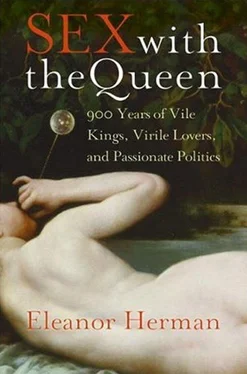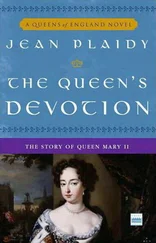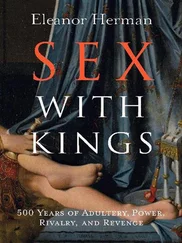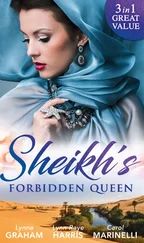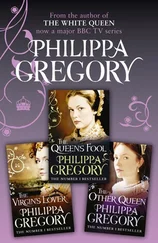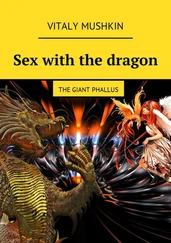Desperate for an heir, Enrique attempted a crude type of artificial insemination. The king was masturbated—by whom records don’t say, perhaps by a doctor. The bit of ejaculate coaxed out of him, which was described as “watery,” was inserted by means of a kind of golden turkey baster into the queen, who was lying in bed with her legs in the air. It must have been horribly humiliating for both.
In 1461 the queen was pregnant. Enrique was delighted, thrilled; finally he had proved himself a man. The golden turkey baster had worked, and, although it had not been accomplished in the usual way, he was going to have a child. But courtiers merely snickered. They knew the queen had been allowing a handsome young courtier, Beltran de la Cueva, into her chamber. In February a little girl was born, a princess named Juana after her mother, but whom Castilian courtiers and soon all of Europe nicknamed “La Beltraneja” after her real father. And indeed she was his spitting image.
The king later divorced his erring wife, who continued to get pregnant long after Enrique had stopped trying the golden turkey baster trick. Enrique named his younger half sister Isabel of Castile as his heir. The two of them signed a joint document proclaiming that Queen Juana “had not used her person cleanly as complies with the service of the king nor her own.” 14Isabel married Prince Ferdinand of Aragon, and together they launched Columbus into the New World. They also launched the inconvenient princess Juana la Beltraneja into a convent where she could make no claims on their throne.
ANNE BOLEYN, QUEEN OF ENGLAND
“She Excelled Them All”
It is ironic that the most famous queen ever executed for adultery was wholly innocent. The raven-haired Anne Boleyn, though she was vicious and vengeful and had a heart like a chunk of ice and a tongue as sharp and tearing as a meat cleaver, had always been faithful to her marriage bed. But it was never sex alone that did in a queen, even if Anne had been guilty. It was politics.
In 1526 Henry VIII, casting about court for a new mistress, fell passionately in love with Anne, the nineteen-year-old niece of the powerful Howard clan. Ambitious in a world where women held little power, Anne realized that as royal mistress she could whisper suggestions into the king’s ear after lovemaking, seeds that often took root and bore fruit. But her older sister Mary, blond and soft and pretty, had been Henry VIII’s mistress and was cast aside like used goods. No. Anne would never stand for that.
And then she looked at the queen, old and barren at forty-one, hobbled with arthritis, her waist thick from years of fruitless childbearing. Henry had not slept with Queen Catherine, a Spanish princess, in years. All the queen’s children, except a useless girl, had died at birth. Why should Henry not divorce his barren wife and marry young fertile Anne to beget sons? Queen Anne. Ah, that would be power indeed.
At thirty-five, Henry was at his physical peak. He stood six foot one, a giant for his time. He was powerful in his physique, and though he had gained weight recently he carried it magnificently beneath his padded, broad-shouldered coats. He had short red-gold hair and a cropped beard. His ice blue eyes were small, intense, and never missed a thing.
Henry was the quintessential Renaissance man. He played the lute, the virginals (an early kind of organ), the recorder, and the harp. He wrote music, sang, and pirouetted gracefully on the dance floor. He spoke four languages fluently, composed poetry and music, and pursued astronomy and science. An avid sportsman, he rode, jousted, threw spears, bowled, and played tennis. Henry was a man of keen intellect, deep religious devotion, and outbursts of vicious cruelty. He was an utterly selfish man who could not bear to hear he would not get his way. And now he wanted his way with Anne Boleyn. And ambitious Anne wanted her way with him.
But to keep the king interested for the years it would take to unharness himself from Queen Catherine, Anne had to awaken his desires without assuaging them. And so she became his mistress in all things but sex. Vivacious Anne offered Henry friendship, entertainment, witty conversation, challenging political dialog, and theological debates. She danced, sang, played the lute, hunted with him, and organized tournaments and pageants for his amusement. Anne held out the promise of incredible sex and numerous sons to her overheated monarch, if only he would divorce his faithful queen and marry her.
Like many royal mistresses before and since, Anne was no classic beauty but made up for it with charm and personality—she made a room crackle with life by simply stepping into it. A palace servant remembered Anne “for her excellent grace and behavior.” Another wrote, “Albeit in beauty she was to many inferior, but for behavior, manner, attire and tongue, she excelled them all, for she had been brought up in France.” 15Her greatest asset was her rapid-fire wit. Conversing with Anne was akin to fencing, the thrusts and retreats of sharp blades.
The Venetian ambassador wrote, “Madame Anne is not one of the handsomest women in the world; she is of middling stature, swarthy complexion, long neck, wide mouth, bosom not much raised, and in fact has nothing but the English king’s great appetite and her eyes, which are black and beautiful.” 16Her unbounded self-confidence made her seem beautiful, though her skin was a bit sallow, her chest a bit flat.
Anne led the fashions at Henry’s court, trading in the tight wrist-length sleeves for wide sleeves hanging down to the knee. She rejected the unattractive peaked gable headdress for the lovely crescent-shaped French cap. Anne wore rich gowns of royal purple, a color reserved for royalty, embroidered with silver and gold and studded with precious gems.
Her life as queen-in-all-but-name at the numerous Tudor royal palaces was luxurious. The magnificence of the king was manifested in his lodgings, apparel, barges, and coaches. Royal rooms were decorated with elegant tapestries in vivid colors, elaborately carved tables, and chairs upholstered in velvet. Anne sat in the queen’s chair of estate at royal events and presided over great feasts. Her huge four-poster bed boasted gold fringe from Venice and gold tassels from Florence. She accompanied the king as he went on his rounds to the various royal palaces—often thirty trips a year.
The court’s absence allowed the staff to clean out a residence, wash the walls of urine, sweep out the flea-ridden rushes on the floor, and allow the water supply in palace wells to build up. Henry was one of the few premodern rulers who abhorred dirt. He issued edicts prohibiting urinating in hallways and throwing food on floors. Peeing in the king’s cooking hearth was strictly forbidden. Palace officials painted large red crosses on outside walls that were frequent targets of urination in the hopes that no one would want to desecrate such a holy symbol. They were often disappointed.
Henry made sure his palaces had conduit systems, a spring-fed early type of plumbing which used lead pipes to bring water to kitchens, fountains, fishponds, and gardens and had the added value of flushing out the sewers beneath the palace. The royal family, and the most important courtiers, had running water in their own rooms, though it was not usually heated. Henry VIII’s bath at Hampton Court, however, had water piped in hot from a stove in the room next door. Despite Henry’s momentous efforts to achieve cleanliness, he was often pestered by fleas and lice, and he usually wore a piece of fur to bed in the hopes that the critters would jump on the fur and not on the king.
But the unprecedented cleanliness and luxury of Henry’s court were not enough for Anne. She had a political agenda. At Anne’s goading, Henry exiled his devoted wife to a drafty castle where she would die, and he publicly proclaimed his daughter, Princess Mary, a bastard. He then broke from the Catholic Church, putting to death all subjects who would not recognize him as head of the Church of England. He tossed monks and nuns into the streets and grabbed church properties for himself. Time-honored political alliances were shattered, new ones were forged. Like a puppeteer, this not pretty daughter of the minor nobility held the strings to the kings and queens and cardinals of Europe, the pope and the Holy Roman Emperor and, by lifting a finger, made them dance.
Читать дальше
